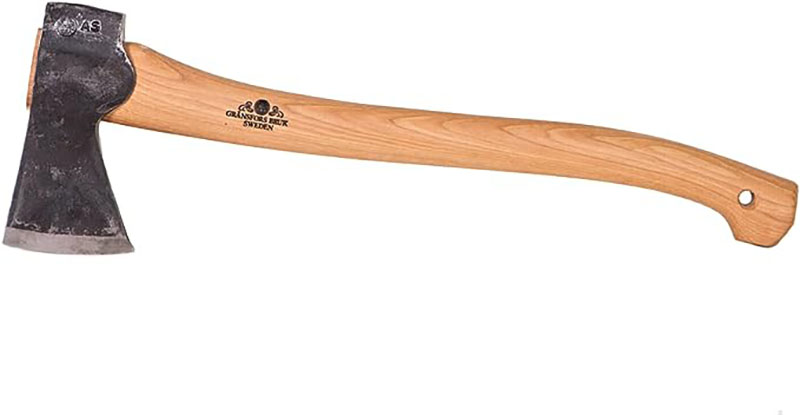

Whether you’re taking camping trips or backpacking adventures, a camping axe is an invaluable item to keep with you. It’s a versatile tool for things like chopping wood, splitting kindling, or clearing fallen trees.
Videos by Outdoors
Yet, while we probably all have an idea of what a camping axe is – something bigger than a hatchet but smaller than a splitting maul – there are tons of options to choose from. That’s why we curated a list of the best camping axes available today.
We picked the Gransfors Bruks Small Forest Axe as our pick for the best camping axe because of its performance, size, and aesthetics. We also offer options for everything ranging from a compact hatchet to a large axe and everything in between so you can see the cutting edge in wood-splitting technology.
This post contains affiliate links. Outdoors.com may earn a commission when you make a purchase through these links. Thank you for your support.
The Best Camping Axes
- Best Overall – Gransfors Bruks Small Forest Axe
- Best Value – Estwing Camper’s Axe
- Best for Wood Splitting – Husqvarna Composite Splitting Axe
- Best for Tree Felling: Hults Bruk Kisa Axe
- Best for Backpacking Adventures: Gerber Freescape
Best Overall: Gransfors Bruks Small Forest Axe

For the best camping axe, we picked the Gransfors Small Forest Axe. With a hickory handle and stainless steel blade, it has that traditional look but is still extremely effective for handling multiple tasks competently.
Measuring 19 inches in length and weighing 2 pounds, the Gransfors Small Forest Axe is very well-balanced and compact. Plus, it’s extremely sharp, making it capable of handling tasks ranging from trail clearing to chopping kindling.
It’s not the best to chop wood or cut down trees, but it wasn’t designed for heavy hitting. The Gransfors Bruks camping axes can also be expensive, but they’ll last you damn near forever.
Features & Specs
- Handle: Hickory Wood
- Blade: Stainless Steel
- Length: 19 inches
- Weight: 2 pounds
Best Value: Estwing Camper’s Axe

For our budget option, we picked the Estwing Camper’s Axe. However, measuring at 16 inches in length, it could really be called the best budget hatchet.
What’s great about the Camper’s Axe is, like all Estwing tools, its durability. It was crafted from nearly 3 pounds of dense American steel, so the blade and handle are a single solid piece.
Although it does have the heft, it’s just not long enough for chopping down trees or splitting logs. Despite that, it’s a great value as it’s a solidly built, sharp, and well-balanced tool.
Features & Specs
- Handle: American steel
- Blade: American steel
- Length: 16 inches
- Weight: 2.8 pounds
Best for Wood Splitting: Husqvarna Composite Splitting Axe

For the best wood-splitting axe, we picked the Husqvarna Composite Splitting Axe. Some people might guffaw at the non-traditional composite handle, but people who own the splitting axe swear by it.
The handle is both lightweight and easy to hold. Also, the blade is coated with a proprietary low-friction coating, so it won’t get stuck in the wood as you chop. It’s great for its size and weight. Plus, behind the sharpened edge is a hammerhead.
Husqvarna said it designed the axe with the “perfect balance and weight distribution” with the lightweight handle and oversized head. Although it’s pretty good, the main criticism is that the axe head does get stuck in larger logs, but to that we say, it’s a camping axe.
Features & Specs
- Handle: Composite
- Blade: Stainless Steel
- Length: 27.5 inches
- Weight: 6.17 pounds
Best for Tree Felling: Hults Bruk Kisa Axe

For the best tree-felling axe, we picked the Hults Bruk Kisa Axe. With a hand-forged steel head and a hickory handle treated with boiled linseed oil, this Hults Bruk axe is probably one of the best-looking axes on this list. But it’s also one heck of a splitting axe.
Measuring 29 inches in length and weighing a little more than 3 pounds, the Kisa Axe is very well-balanced and easy to handle. Plus, it has a versatile head shape and a sharp edge.
While most users love the performance, they often list two criticisms. The first is that out of the box, the handle might feel rough and splintered, so you might have to sand it down. Second, it’s priced north of $200, but with the traditional look, it’ll age extremely well.
Features & Specs
- Handle: American hickory
- Blade: Alloy steel
- Length: 29 inches
- Weight: 3.17 pounds
Best for Backpacking Adventures: Gerber Freescape

For the best backpacking adventures axe, the Gerber Freescape hatchet is the choice for you. This camping axe is not the most attractive, compared to other options on this list, but it is small, lightweight, and extremely functional.
What makes the Gerber Freescape such a great backpacking tool is that you can use it for everything from splitting kindling to shaving bark off logs to hammering in tent stakes to opening cans of beans.
While the Gerber Bushcraft Hatchet might be a more popular and discussed option, most reviewers found that the Gerber Freescape offers better overall performance.
Features & Specs
- Handle: Glass-filled nylon
- Blade: Forged steel
- Length: 14 inches
- Weight: 1.4 pounds
What to Look for in a Camping Axe
There are a crazy amount of axes that exist in this world. You got a grub axe, a felling axe, a splitting maul, a broad axe, a carpenter’s axe — we could keep going, but it won’t make much of a difference if you’re new to axes. Instead, there’s a much simpler way of describing most axes.
Experts like Dan from Coalcracker Bushcraft categorize axes into three groups: specific, fire creation, and utility.
In the “specific” group, he describes axes designed for a specific purpose like felling trees or skinning a deer. The “fire creation” axe is intended for splitting firewood. And a “utility” axe is a multi-purpose tool, which you can just as easily use to nail tent stakes as you could split wood.
While each group might have some overlapping traits — a fire creation axe could easily fit into a specific group — the point is that you should understand that not all axes are the same. However, he added that if you’re looking for a camping axe, you’ll generally want either a fire creation or a utility axe.
Features of a Camping Axe
Additionally, there are three features to take note of when you’re shopping for a camping axe. These include head weight, bit shape, and handle length.
- Head Weight – When you think about weight, the main thing to know is that an axe with a heavier head is meant for chopping down trees or splitting wood while an axe with a lighter head is meant for carving. An axe with a head weight of more than 3 pounds is generally considered “heavy.”
- Bit Shape – When we talk about the shape of the “bit,” or the axe head design, we’re referring to the thickness of its cutting edge. An axe with a wide bit is designed for splitting while a narrow bit is designed for carving.
- Handle Length – A longer handle will help you generate greater chopping power when you swing your axe while a shorter handle will help you be more precise. A full-size axe is considered longer than 19 inches while a short one is considered, you guessed it, less than 19 inches.
The takeaway here is if you want an axe just for splitting wood or chopping down trees, you’ll want a heavier, thicker head with a long handle. A middle-of-the-road option will feature a 2.5-pound axe head and measure 18 or 19 inches in length.
Key Features
Traditional camping axes use steel axe heads and wooden handles. Today, you can find camping axes made out of a variety of materials. For instance, the axe head could be made from carbon steel or hand-forged steel head and it could have a hickory handle or plastic with a rubber grip.
FAQs about Camping Axes
What’s the difference between axes and hatchets?
While it seems like size is the obvious answer here, axes and hatchets are different tools. An axe is typically meant for physically demanding tasks like splitting logs or felling trees while a hatchet is more of a precision tool for light tasks like carving wood or splitting kindling.
What is the best size axe for camping?
When anyone asks what the best anything is — let alone the best camping axe — the answer is the one that is the easiest for you to use correctly. However, experts giving ballpark figures recommend a camp axe measuring 18 or 19 inches in length with a 2.5-pound axe head.
How sharp should a camp axe be?
When it comes to camping axes, the U.S. Forest Service says in its axe manual that “a sharp axe is a safe axe.” What the agency means by that is a sharp blade is more effective at splitting wood.
Conversely, a dull blade will require that you swing harder, and if you swing harder, you’ll have less control. Less control will result in increased danger. So keep a sharpened edge on your camp axe and when you’re not using it, cover it with a leather or plastic sheath.
The Best Camping Axes
If you’re looking for a camping axe that delivers high-end performance and pleasing aesthetics, the Gransfors Bruks Small Forest Axe will serve you well.
Of course, if you can’t bring yourself to spend $200 on an axe, you could pick up the Estwing Camper’s Axe for a great multi-purpose tool, or the Fiskars Chopping Axe if all you want to do is split wood and chop down trees.










The GB axe is high carbon steel and will rust. Great axe. I really like it.